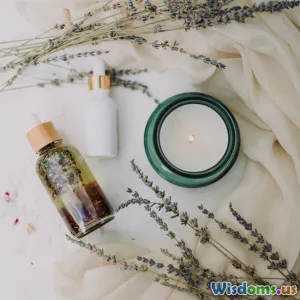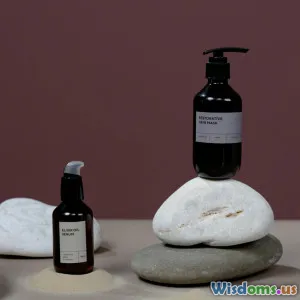
Comparing Retinol And Bakuchiol For Youthful Skin
15 min read Explore the differences and benefits of retinol and bakuchiol for maintaining youthful, radiant skin. (0 Reviews)
Comparing Retinol And Bakuchiol For Youthful Skin
If your pursuit of youthful, glowing skin has led you into the world of skincare actives, you've likely encountered both retinol and bakuchiol. Once dominated singularly by the popularity of retinol, the conversation around anti-aging now includes this newer, plant-derived competitor. But how do retinol and bakuchiol measure up—especially when it comes to results, tolerability, and long-term benefits? Let’s break down the science, real-world examples, and practical tips to help you decide which might be right for your routine.
What Are Retinol and Bakuchiol—And Why All The Buzz?

Retinol, a derivative of vitamin A, has long been crowned the gold standard in dermatology for its multifaceted approach to improving signs of age, acne, and uneven skin. It works primarily by accelerating cell turnover and boosting collagen production, both vital as our natural regeneration slows.
Bakuchiol, by contrast, is a plant extract sourced from the seeds and leaves of the Babchi plant (Psoralea corylifolia). Over the last few years, it's gained acclaim as the “natural retinol alternative;” brands tout its potential to deliver retinol-like benefits with less irritation.
But why such fervor? Much revolves around consumer desire for potent, yet gentle skin solutions—and a growing interest in botanical or “clean beauty” practices. Researchers and product formulators alike are seeking to balance efficacy with minimal side effects, especially for sensitive skin types.
Mechanisms of Action: Science Beneath the Surface

Retinol’s Pathways
Retinol’s effectiveness comes from its conversion to retinoic acid when applied to the skin. This active form binds to skin cell receptors, triggering collagen synthesis and increasing the rate at which old skin is sloughed off. Consistently, clinical studies confirm its impact: pausing the march of fine lines, improving texture, and evening pigmentation.
- Clinical data highlights: A 2007 study in Archives of Dermatology reported significant wrinkle reduction and improved skin elasticity after 24 weeks of retinol treatment at concentrations as low as 0.4%.
How Bakuchiol Works
Bakuchiol hasn’t yet been shown to follow the exact same pathway as retinol—chemically, it is quite different. However, recent research demonstrates that it activates similar gene targets responsible for skin matrix repair and antioxidation, but without the presence of vitamin A.
- Key study: In a 2018 double-blind trial published in the British Journal of Dermatology, bakuchiol was shown to perform comparably to retinol in reducing wrinkles and hyperpigmentation over 12 weeks, with remarkably fewer reports of stinging or skin scaling.
Comparing Efficacy: Wrinkle Smoothing, Texture, and Beyond

Consumers yearn for proofs, not just promises. In side-by-side applications, both retinol and bakuchiol have been observed to improve skin texture and target visible aging. However, differences do become apparent, especially in timelines and user experiences.
Retinol’s Track Record
- Onset of results: Typically requires 12 weeks or more for visible improvement, with the best results often seen around the 6-month mark.
- Concerns addressed: Fine and coarse wrinkles, sun spots, laxity, acne, and uneven skin tone.
- Limiting factors: Potential mild to moderate irritation—dryness, redness, flaking—especially in the early weeks or if overused.
Bakuchiol in Practice
- Onset of results: Studies and user reports suggest improvement within 12 weeks, matching retinol in terms of wrinkle and pigment reduction.
- Concerns addressed: Wrinkles, pigmented spots, overall skin firmness; not established for acne to the same degree as retinol.
- Tolerance: Almost uniquely, bakuchiol demonstrates a low risk of causing skin irritation. In user studies, subjects did not display the scaling, redness, or sensitivity often attributed to retinol.
Real-world example: Consider Jane, a 45-year-old who switched from retinol to bakuchiol after persistent dryness. After consistent bakuchiol use for three months, she noted similar improvements in her forehead lines—but without peeling or redness. For those unable to tolerate retinoids, the option of bakuchiol is significant.
Safety and Sensitivity: Who Can Use What?

Not everyone’s skin reacts the same. Side effects and sensitivities can tilt the scales when choosing an active.
Retinol Considerations
- Potency and irritation: Retinol may be too harsh for some, manifesting as redness, stinging, flaking, or even exacerbation of eczema and rosacea.
- Safety for sensitive demographics: Not recommended during pregnancy, as high levels of vitamin A analogs are linked to risk of birth defects. Children and those with highly reactive skin should avoid retinoids.
Bakuchiol’s Gentle Profile
- Sensitive and tolerant: Bakuchiol’s milder approach suits users previously excluded from retinols, including those with rosacea, eczema, or highly sensitive skin. Allergenic responses are rare and generally mild.
- Pregnancy and breastfeeding: While safety data is promising—even appearing safe for pregnancy—definitive large-scale studies are still lacking, so consult with a healthcare professional.
Patch Testing Advice
With any new skincare ingredient, patch-testing is a must. Apply a small amount behind the ear or on the inner arm for a few days before broad facial use, particularly if you have a history of reactions.
Usage: Incorporation Into Your Routine

Integrating actives effectively is crucial to maximize benefits—and minimize risk.
Application Methods
- Retinol: Apply at night, directly to clean, dry skin. Start with 2-3 times per week, increasing gradually. Layering with moisturizer can buffer irritation. Avoid mixing with certain acids (AHAs, BHAs) initially, and always begin with pea-sized amounts.
- Bakuchiol: Can be used both morning and evening; stable under light and in most formulations. Typically found in serums, oils, and creams.
Layering With Other Ingredients
- Retinol cautions: Avoid typical retinol pairings with Vitamin C (in the same routine) and exfoliating acids at first due to sensitization risk. Hydrating ingredients—niacinamide and ceramides—are good companions.
- Bakuchiol’s flexibility: Generally pairs well with most ingredients, making it versatile in both simple and multi-step routines.
Realistic Timelines
- Expect gradual improvements; stick with a product for at least three months before deciding efficacy. Both ingredients generate best results with consistent and correct use.
Side Effects and Troubleshooting Common Issues

If You Experience Irritation With Retinol
- Scale back usage: Drop down to fewer nights or dilute with moisturizer.
- Use buffer creams: Apply a gentle hydrating lotion before or after your retinol.
- SPF is non-negotiable: Retinoids can increase sun sensitivity, so sunscreen is essential.
Minimizing Issues With Bakuchiol
- Reports of side effects are rare, but monitor for subtle redness or rashes, particularly if you combine with intense actives.
- Because bakuchiol lacks extensive long-term safety data compared to retinol, continue to monitor skin for any changes.
Suitability For Diverse Skin Tones and Types

Both retinol and bakuchiol have broad appeal, but their performance nuances matter with different skin tones and conditions.
- Retinol can sometimes induce post-inflammatory hyperpigmentation, an especially acute concern for deeper skin tones.
- Bakuchiol, given its lower irritation profile, may better suit melanin-rich skin; it provides wrinkle, tone, and texture improvements with low inflammatory risk. Trials to date have reported positive outcomes in a chemotype-diverse population.
- Oily or acne-prone skin: Retinol’s advantages with acne control are unmatched. While bakuchiol shows some promise due to its antibacterial and anti-inflammatory potential, it is not yet widely adopted as a primary acne treatment.
Myth Busting: Clearing Up Common Misconceptions

- "Bakuchiol is just as strong as retinol." Not necessarily; while similar benefits have been documented, individual potency and depth of results (especially for deep wrinkles or severe acne) may lean in retinol’s favor.
- "Plant-based means gentler for everyone." Plant actives can still be allergenic, particularly in those allergic to related herbs. Always patch test.
- "Natural means safe during pregnancy." As discussed, bakuchiol shows promise but isn’t absolutely confirmed for pregnancy use—consult professionals.
Sustainability And Sourcing: The Ethical Angle

Another factor increasingly on consumers’ minds: how ingredients are sourced and their environmental footprint.
- Retinol is typically synthesized in labs. While manufacture is controlled and scalable, the production of retinoids is energy-intensive and relies on the petrochemical industry.
- Bakuchiol comes from the Babchi plant, raising questions about over-harvesting and sustainability. Some brands commit to sustainable farming and fair-trade harvesting. Look for suppliers or brands that certify their sourcing practices if this matters to you.
- Packaging: Regardless of the active, prioritize brands offering recyclable or reduced-waste packaging, reflecting a broader commitment to planetary health.
Making Your Choice: Factors To Consider

When weighing retinol vs. bakuchiol, a few guidelines will help you tailor your approach:
Choose Retinol If:
- You’re seeking maximal results for deeper lines, sun damage, or persistent acne.
- Your skin tolerates moderate actives with only minimal or transient irritation.
Choose Bakuchiol If:
- You are prone to sensitivity, seeking a plant-based option, or wanting to integrate actives both day and night.
- You’re pregnant, breastfeeding, or otherwise contraindicated for retinoids (after consulting a physician).
For Best of Both Worlds
Some brands now combine both ingredients, taking advantage of retinol’s potency and bakuchiol’s soothing properties—delivering powerful results with reduced potential for irritation. Keep an eye out for innovative dual-action serums.
Tips for Skincare Success with Actives

- Start low and slow: Build up your skin’s tolerance to either ingredient. A pea-sized amount applied a few times a week is a solid beginning.
- Pair with hydration: Always balance actives with barrier-repairing hydrators—think hyaluronic acid, squalane, ceramides.
- Don’t forget sunscreen: Protect your investment. Sun exposure can undo the gains achieved with your anti-aging routine, especially with retinoids.
- Monitor and adjust: Track your skin’s reaction and progression over time. Adjust frequency or formulation as needed.
When it comes to unlocking youthful, vibrant skin, both retinol and bakuchiol offer powerful, evidence-based approaches. Consider your sensitivities, lifestyle, and skincare goals—then take the leap with confidence, knowing that science and innovation have paved diverse paths toward healthy, resilient skin.
Rate the Post
User Reviews
Other posts in anti-aging
Popular Posts














